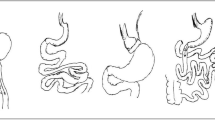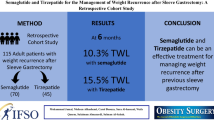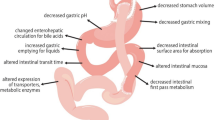Abstract
Purpose
Long-term parenteral nutrition following massive bowel resection causes liver dysfunction, such as intestinal failure-associated liver disease (IFALD). IFALD includes two different states, cholestasis and steatosis, which represents a life-threatening complication. The previous reports have shown the protective role of ghrelin in the liver. The aim of this study was to evaluate the effects of the administration of ghrelin in the liver in a parenterally fed rat model of short bowel syndrome (SBS).
Methods
Rats underwent jugular vein catheterization, and were divided into three groups: 90 % small bowel resection (90 % SBR) and TPN (SBS/TPN group), 90 % SBR and TPN plus ghrelin (SBS/TPN/ghrelin group), and sham operation with normal chow (sham group). Ghrelin was administered continuously at a dose of 10 μg/kg/day. On day 13, all rats were euthanized. The serum chemistry was analyzed, the lipid content of the liver was measured, and the liver tissue was histologically analyzed.
Result
The AST and LDH levels significantly increased, and the accumulation of lipids in the liver was observed in the TPN/SBS group. The accumulation of lipids in the liver of the rats in the SBS/TPN group was attenuated by the administration of ghrelin.
Conclusion
The administration of ghrelin has a therapeutic potential for IFALD.

Similar content being viewed by others
References
Wales PW, de Silva N, Kim JH, Lecce L, Sandhu A, Moore AM (2005) Neonatal short bowel syndrome: a cohort study. J Pediatr Surg 40(5):755–762. doi:10.1016/j.jpedsurg.2005.01.037
McMellen ME, Wakeman D, Longshore SW, McDuffie LA, Warner BW (2010) Growth factors: possible roles for clinical management of the short bowel syndrome. Semin Pediatr Surg 19(1):35–43. doi:10.1053/j.sempedsurg.2009.11.010
Kelly DA (2006) Intestinal failure-associated liver disease: what do we know today? Gastroenterology 130(2 Suppl 1):S70–S77. doi:10.1053/j.gastro.2005.10.066
Kelly DA (1998) Liver complications of pediatric parenteral nutrition–epidemiology. Nutrition 14(1):153–157
Diamond IR, Grant RC, Pencharz PB, de Silva N, Feldman BM, Fitzgerald P, Sigalet D, Dicken B, Turner J, Marchand V, Ling SC, Moore AM, Avitzur Y, Wales PW (2016) Preventing the progression of intestinal failure-associated liver disease in infants using a composite lipid emulsion: a pilot randomized controlled trial of SMOFlipid. JPEN J Parenter Enteral Nutr. doi:10.1177/0148607115626921
Stengel A, Tache Y (2012) Ghrelin—a pleiotropic hormone secreted from endocrine x/a-like cells of the stomach. Front Neurosci 6:24. doi:10.3389/fnins.2012.00024
Kojima M, Kangawa K (2005) Ghrelin: structure and function. Physiol Rev 85(2):495–522. doi:10.1152/physrev.00012.2004
Tomasetto C, Karam SM, Ribieras S, Masson R, Lefebvre O, Staub A, Alexander G, Chenard MP, Rio MC (2000) Identification and characterization of a novel gastric peptide hormone: the motilin-related peptide. Gastroenterology 119(2):395–405
Yamada W, Kaji T, Onishi S, Nakame K, Yamada K, Kawano T, Mukai M, Souda M, Yoshioka T, Tanimoto A, Ieiri S (2016) Ghrelin Improves Intestinal Mucosal Atrophy During Parenteral Nutrition: An Experimental Study. J Pediatr Surg (in press)
Waseem T, Duxbury M, Ito H, Ashley SW, Robinson MK (2008) Exogenous ghrelin modulates release of pro-inflammatory and anti-inflammatory cytokines in LPS-stimulated macrophages through distinct signaling pathways. Surgery 143(3):334–342. doi:10.1016/j.surg.2007.09.039
Tong J, Prigeon RL, Davis HW, Bidlingmaier M, Kahn SE, Cummings DE, Tschop MH, D’Alessio D (2010) Ghrelin suppresses glucose-stimulated insulin secretion and deteriorates glucose tolerance in healthy humans. Diabetes 59(9):2145–2151. doi:10.2337/db10-0504
Li Y, Hai J, Li L, Chen X, Peng H, Cao M, Zhang Q (2013) Administration of ghrelin improves inflammation, oxidative stress, and apoptosis during and after non-alcoholic fatty liver disease development. Endocrine 43(2):376–386. doi:10.1007/s12020-012-9761-5
Sax HC, Talamini MA, Brackett K, Fischer JE (1986) Hepatic steatosis in total parenteral nutrition: failure of fatty infiltration to correlate with abnormal serum hepatic enzyme levels. Surgery 100(4):697–704
Zamir O, Nussbaum MS, Bhadra S, Subbiah MT, Rafferty JF, Fischer JE (1994) Effect of enteral feeding on hepatic steatosis induced by total parenteral nutrition. JPEN J Parenter Enteral Nutr 18(1):20–25
Nabeshima A, Yamada S, Guo X, Tanimoto A, Wang KY, Shimajiri S, Kimura S, Tasaki T, Noguchi H, Kitada S, Watanabe T, Fujii J, Kohno K, Sasaguri Y (2013) Peroxiredoxin 4 protects against nonalcoholic steatohepatitis and type 2 diabetes in a nongenetic mouse model. Antioxid Redox Signal 19(17):1983–1998. doi:10.1089/ars.2012.4946
Hua Z, Sergi C, Nation PN, Wizzard PR, Ball RO, Pencharz PB, Turner JM, Wales PW (2012) Hepatic ultrastructure in a neonatal piglet model of intestinal failure-associated liver disease (IFALD). J Electron Microsc (Tokyo) 61(3):179–186. doi:10.1093/jmicro/dfs035
El Kasmi KC, Anderson AL, Devereaux MW, Fillon SA, Harris JK, Lovell MA, Finegold MJ, Sokol RJ (2012) Toll-like receptor 4-dependent Kupffer cell activation and liver injury in a novel mouse model of parenteral nutrition and intestinal injury. Hepatology 55(5):1518–1528. doi:10.1002/hep.25500
Asakawa A, Inui A, Kaga T, Yuzuriha H, Nagata T, Ueno N, Makino S, Fujimiya M, Niijima A, Fujino MA, Kasuga M (2001) Ghrelin is an appetite-stimulatory signal from stomach with structural resemblance to motilin. Gastroenterology 120(2):337–345
Gura KM, Parsons SK, Bechard LJ, Henderson T, Dorsey M, Phipatanakul W, Duggan C, Puder M, Lenders C (2005) Use of a fish oil-based lipid emulsion to treat essential fatty acid deficiency in a soy allergic patient receiving parenteral nutrition. Clin Nutr 24(5):839–847. doi:10.1016/j.clnu.2005.05.020
Levy JR, Clore JN, Stevens W (2004) Dietary n-3 polyunsaturated fatty acids decrease hepatic triglycerides in Fischer 344 rats. Hepatology 39(3):608–616. doi:10.1002/hep.20093
Harmon RC, Tiniakos DG, Argo CK (2011) Inflammation in nonalcoholic steatohepatitis. Expert Rev Gastroenterol Hepatol 5(2):189–200. doi:10.1586/egh.11.21
Koek GH, Liedorp PR, Bast A (2011) The role of oxidative stress in non-alcoholic steatohepatitis. Clin Chim Acta 412(15–16):1297–1305. doi:10.1016/j.cca.2011.04.013
Acknowledgments
We thank Mr. Brian Quinn for comments and help with the manuscript. This study was supported by a Grant-in-Aid for Scientific Research from the Japan Society for the Promotion of Science (JSPS, Nos. 25462777, 16K10094, 16K10095, 16K10434, and 16K10466,). This study was supported by the Institute of Laboratory Animal Sciences, Kagoshima University (Frontier Science Research Center).
Author information
Authors and Affiliations
Corresponding author
Ethics declarations
Conflict of interest
The authors declare no conflicts of interest in association with the present study.
Rights and permissions
About this article
Cite this article
Onishi, S., Kaji, T., Yamada, W. et al. The administration of ghrelin improved hepatocellular injury following parenteral feeding in a rat model of short bowel syndrome. Pediatr Surg Int 32, 1165–1171 (2016). https://doi.org/10.1007/s00383-016-3975-1
Accepted:
Published:
Issue Date:
DOI: https://doi.org/10.1007/s00383-016-3975-1




